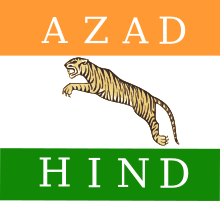A. D. Loganathan
| Arcot Doraiswamy Loganadan | |
|---|---|
| Born | 12 April 1888 |
| Died | 9 March 1949 (aged 60) |
| Allegiance |
|
| Service/ | Indian National Army (World War II) |
| Rank | Major General (World War II) |
| Battles/wars |
World War I World War II |
| Relations | Saroja (m. 1919) |
Major General Arcot Doraiswamy Loganadan [1][2] (12 April 1888 – 9 March 1949) was an officer of the Indian National Army, and a minister in the Azad Hind Government as a representative of the Indian National Army. He also served briefly as the Azad Hind Governor for the Andaman islands[3][4] and Burma.[5]
Loganadan (spelled 'Loganathan' in most historical references) attended the RBANM'S School and subsequently the Central College of Bangalore before enrolling as a student of medicine in the Madras Medical College and later training in London as a doctor of tropical diseases.
He received a temporary commission as a lieutenant into the Indian Medical Service on 27 August 1917, and was later promoted temporary Captain. He was appointed to a regular commission in the Indian Medical Service 1 March 1922. He was promoted Major 27 February 1929.[6] Loganadan served during World War I.
By April 1940 he had been promoted Lieut-Col 15 December 1939.[7]
During World War II, Loganadan joined the Indian National Army following the fall of Singapore and joined the Azad Hind Government under Subhas Chandra Bose to free India from British rule. He was also appointed the Governor of the Andamans and Nicobar Islands during its brief occupation during World War II when it was transferred to Azad Hind authority from the Japanese Navy.
Bad health and severe differences with the Japanese Forces of Occupation led ultimately to Loganadan relinquishing authority and returning to Burma. Later, towards the end of the successful Allied Burma Campaign, Loganadan was appointed the G.O.C(General officer commanding) of the Indian National Army's Burma Command as the Azad Hind Government withdrew from Rangoon. Without a regular police force or security forces, his troops, an INA Contingent 6,000 strong INA contingent formally surrendered to released British PoWs held in the city and manned the Burmese Capital, successfully maintaining law and order between 24 April and 4 May 1945.
Loganadan was later repatriated to India and held at the Red Fort as preparations for were made to try the men of the Indian National Army for treason. He returned to his family in Bangalore in 1946 after the completion of the trials and his acquittal. He was however removed from the Indian Army as a Lt-Col, IMS in the London Gazette 20 September 1946. He declined a diplomatic assignment to New Zealand under the Nehru Government because of failing health.
Family
Loganadan was married to Saroja Loganadan, with whom he had five children - Sampath Loganadan, Lalitha Loganadan, Sukumar Loganadan, Menaka Loganadan and Coomalatha Loganadan (m. C. D. Gopinath).
Legacy
Bangalore's Edward Road was renamed Major General A D Loganadan Road by then Chief Minister S. M. Krishna, in honour of the former's life and work. This was the road on which the Loganadan residence once stood, until it gave way to a building called Cunningham Apartments in the 1980s.
See also
References
- ↑ "Forgotten heroes of India's first army".
- ↑ Roll of the Indian Medical Service 1615-1930 by D. G. Crawford, p583.
- ↑ Singh, N. Iqbal. The Andaman Story. Delhi, IN: Vikas Publishing, 1978. ISBN 9780706906325.
- ↑ "Provinces of British India".
- ↑ Allen, Louis (1986). Burma: the Longest War 1941-45. J.M. Dent and Sons. ISBN 0-460-02474-4.
- ↑ Roll of the Indian Medical Service 1615-1930 by D. G. Crawford, p583.
- ↑ April 1940 Indian Army List
External links
- The Provisional Government of Azad Hind, from the National Archives of Singapore.
- The last straw that broke the back of the British empire. From Yoruzubampo.
- Did you know Loganadan went to school here?. The Hindu 26 February 2002.
